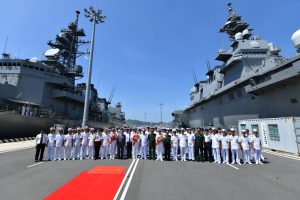On April 16, Japan’s Maritime Self-Defense Force (MSDF) announced their 2024 Indo-Pacific Deployment (IPD 24), which will last from May 3 to December 15. The deployment marks the longest IDP to date and will include both 26,000-ton helicopter-carrying destroyers, JS Kaga and JS Izumo, for the first time.
Six warships, two P-1 maritime patrol aircraft, a special boarding team, and submarines assigned to eight task groups will deploy in total.
The force aims to improve the MSDF’s tactical proficiency and interoperability with allies while contributing to regional stability through enhancing mutual understanding with partner navies.
Task groups will do this by participating in eight exercises and visiting at least 13 countries. Nine of the 13 scheduled visits are to Oceania nations.
2024 marks the third year Japan has prioritized Oceania engagement during the deployment. IPD 22 and 23 each visited eight Oceania nations and participated in several regional exercises, including Pacific Partnership 2023.
The Oceania emphasis is part of Japan’s effort to increase regional engagement, especially on security matters, as demonstrated by the March 2024 Japan-Pacific Islands Defense Dialogue. Concerns about China’s increased presence in the Western Pacific likely drive some of Japan’s efforts.
Concurrent with the Oceania outreach is the “accelerated” use of the MSDF as a diplomatic tool to promote a favorable security environment and foster a Free and Open Indo-Pacific (FOIP). This marks a newer role for the MSDF.
Historically, MSDF naval engagements were limited to overseas training cruises for recent graduates of the Officer Training School. The first training cruise occurred in 1957, three years after the MSDF’s establishment. The annual cruises exposed the new officers to the world and promoted friendly relations during port visits.
After the Cold War, active participation in multilateral organizations like the Western Pacific Naval Symposium provided the MSDF a forum for engagement on regional maritime security matters.
A significant shift in naval diplomacy occurred following the National Defense Program Guideline for Fiscal Year 2005, as well as the 2009 law on “Punishment of and Measures against Acts of Piracy.” These guidelines required the MSDF to actively engage internationally by conducting peacetime regional maritime operations like counterpiracy and disaster relief. The law also enabled the MSDF to protect shipping globally and participate in international counter-piracy operations.
Japan deployed its first counterpiracy force in February 2009. The new mission demonstrated Japanese commitment to the international system and significantly increased naval diplomacy opportunities. The MSDF has frequently taken advantage of these deployments to visit ports throughout the Indo-Pacific region.
Japan implemented the IPD in 2017. The deployment supported Japan’s new FOIP strategy by promoting regional peace and stability through naval engagement. Given the diplomatic significance, the deployment’s training and visits were selected based on foreign policy requirements. The whole-of-government approach also represented a change in naval diplomacy, as the Ministry of Defense had almost solely decided on previous efforts.
In 2019, the IDP operated in the South China Sea, participating in multiple exercises. These exercises signaled Japan’s willingness to sustain the status quo in the face of unilateral challenges. This strategic messaging complemented Japan’s emphasis on ASEAN. Later in the year, an updated Japan-ASEAN security initiative outlined opportunities for closer cooperation and support for FOIP. Tokyo’s efforts underscored its growing importance to Southeast Asia.
Despite scale-backed IPD engagements during the worldwide spread of COVID-19, the MSDF still prioritized ASEAN. The 2020 deployment conducted two port visits, including a submarine stopover at Cam Ranh, Vietnam.
IPD 21 saw a return to full naval engagement as task forces conducted nine port visits, including three in Oceania. The prioritization of Oceania in 2022 coincided with the signing of the Australia-Japan Reciprocal Access Agreement for defense forces, making it easier for the MSDF to operate in the region.
Post-pandemic expanded engagement continued with a record number of port visits (17) and exercises (27) in 2023. While most visits occurred in Oceania, South China Sea exercises garnered regional attention. Multilateral training and an IDP-only antisubmarine warfare drill in the South China Sea demonstrated Japan’s flexible deterrence operations capability in response to threats to the status quo. Some Japanese experts even viewed the exercises as a shift in Japan’s engagement strategy, from convincing nations to embrace FOIP to collaborating with like-minded nations to deter threats.
China did not welcome the potential shift. Beijing has criticized the IPDs as endangering regional security, even as its own naval operations significantly expanded. Chinese military expert Du Wenlong declared Japan’s IPDs an opportunity for the MSDF to conduct “far-sea offensive combat exercises.”
This sentiment has not found much buy-in throughout the Indo-Pacific. According to the 2024 State of Southeast Asia Survey, Japan is the most trusted major power by Southeast Asians. Additionally, 91 percent of ASEAN citizens positively evaluate Japan’s proactive contribution to regional peace and stability.
The IPD’s regional engagements have only helped improve positive perceptions of Japan’s value to the Indo-Pacific. As such, these deployments will likely continue for the foreseeable future, adapting to meet Japan’s foreign policy needs.

































